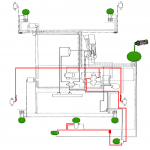Just like to ask if anyone knows how different the early hydraulic system is to the later system with the extra brake sphere. Was this extra sphere to meet local ADR requirements? If so was it installed in Australia by the importer or fitted in France at the factory.
Our GS has some doggy plumbing round the extra sphere supply and return lines. Thinking it may be easier to return to the earlier setup.
Our GS has some doggy plumbing round the extra sphere supply and return lines. Thinking it may be easier to return to the earlier setup.


